42 Essential Central European Pork Dishes You Need To Know
Central European pork dishes represent a culinary tradition deeply rooted in hearty, flavorful cooking that reflects the region's agricultural heritage and rich cultural diversity.
These gastronomic delights showcase remarkable techniques passed down through generations, highlighting skilled preparation methods that transform simple ingredients into extraordinary meals.
Regional chefs have perfected intricate recipes that balance robust meat flavors with complex seasoning profiles and traditional cooking approaches.
Pork plays a significant role in these cuisines, embodying comfort, warmth, and community connection through carefully crafted recipes.
Sophisticated yet unpretentious, these dishes communicate stories of rural landscapes, family gatherings, and time-honored cooking traditions that continue to evolve.
Regional variations demonstrate remarkable creativity in transforming a single protein into numerous mouthwatering interpretations that delight local and international palates.
Each recipe carries historical significance, representing more than just food but also cultural identity and shared memories.
Here are 42 top central European pork dishes that will tantalize your taste buds:
Top Picks for Central European Pork Lovers
Lovers of pork will find plenty to enjoy in Central European cuisine. Tender cuts and rich sauces deliver deep satisfaction in every bite.
Schnitzel Wiener Art
Wiener schnitzel Wiener Art embodies Austrian culinary tradition through its crispy, golden-brown pork cutlet breaded and fried to perfection.
Austrian restaurants commonly serve this dish as an affordable alternative to the classic veal version due to pork's lower cost and wider availability.
German and Austrian regulations require menus to clearly distinguish between traditional veal schnitzel and pork variations.
Precise preparation involves carefully coating the thin meat cutlet in breadcrumbs after gentle pounding.
Skilled cooks typically dredge the meat in flour, dip it in beaten eggs, and cover it completely with fine breadcrumbs.
Professional kitchen techniques ensure an even, crunchy exterior that seals in the meat's juiciness.
Restaurants traditionally serve the schnitzel with potato salad, cucumber salad, or lingonberry jam.
Lemon wedges often accompany the dish, providing a bright, acidic contrast to the rich, crispy meat.
Kotlet Schabowy
Kotlet Schabowy represents a quintessential Polish comfort food featuring a golden-crispy breaded pork cutlet originating from 19th-century Austrian and German culinary influences.
Polish families treasure this classic dish as a hearty midday meal traditionally prepared with tender pork loin or chop pounded thin and coated in breadcrumbs.
Skilled home cooks carefully dredge the meat in flour, beaten eggs, and seasoned breadcrumbs before frying it to a perfect golden-brown in lard or oil.
Restaurants and households across Poland serve the crispy cutlet alongside boiled potatoes, tangy sauerkraut, and fresh seasonal salads.
German culinary techniques significantly influenced its creation, helping establish kotlet Schabowy as a beloved national staple.
Restaurant menus and family dinner tables frequently feature this satisfying dish as a comforting main course.
Schweinshaxe
Schweinshaxe are hearty roasted pork knuckles that epitomize German culinary tradition with their crispy golden exterior and tender meat interior.
Bavarian kitchens specialize in preparing this iconic dish by slow-roasting whole pork knuckles until the skin becomes perfectly crackling and brown.
Oktoberfest celebrations frequently feature this classic dish as a centerpiece of traditional cuisine.
Northern German regions prepare a similar version called Eisbein, which involves curing and boiling the meat instead of roasting.
Restaurants throughout Germany serve Schweinshaxe as a beloved comfort food that connects diners to centuries-old cooking methods.
Restaurant patrons often enjoy the dish with potato dumplings, sauerkraut, or mustard as complementary sides.
Beer remains the preferred beverage pairing for this rich and satisfying German specialty.
Spanferkel
Spanferkel represents a succulent German roasted whole piglet traditionally prepared for celebratory events and special gatherings.
German culinary experts skillfully roast young pigs either whole or cut, using various techniques like oven or spit roasting.
Regional preparations include multiple seasoning methods with spices, herbs, and marinades that enhance the meat's rich flavor profile.
Butter and oil frequently coat the piglet during cooking to ensure crispy, golden skin and tender meat underneath.
Meat drippings create delicious accompanying sauces that complement the roasted pig's intense taste.
Side dishes typically include fresh vegetables and complementary salads that balance the protein's richness.
Weekend festivals and family celebrations often feature this classic meat centerpiece.
Rural and urban German regions maintain this cooking tradition with slight variations in preparation techniques and seasonings.
Schaufele
Schaufele highlights Bavaria's rich pork traditions, featuring a succulent pig shoulder prepared through meticulous regional techniques that transform simple ingredients into a hearty German classic.
Bavarian butchers carefully select premium cuts, seasoning the meat with traditional spices before slow-roasting or boiling to achieve tender perfection.
Baden interpretations showcase a smoked and cured approach, often complemented by tangy potato salad.
Skilled preparation involves marinating the pork with carefully chosen herbs and spices.
Onions and root vegetables frequently enhance the dish's robust flavor profile.
Generations of German families have treasured this comforting meal as a symbol of regional culinary heritage.
Restaurants throughout Bavaria continue to celebrate Schaufele as a quintessential southern German specialty.
Schwenkbraten
Schwenkbraten are succulent German pork steaks grilled on a unique suspended schwenker grill that swings over an open wood fire, creating a signature smoky flavor.
Saarland's beloved barbecue specialty uses neck cuts or alternative pork cuts marinated in a robust blend of herbs and spices.
Dried thyme, oregano, onions, salt, black pepper, and garlic form the marinade's core ingredients.
Juniper berries and optional German Riesling wine enhance the meat's depth of flavor.
Skilled grillers called schwenkmeisters carefully swing the tripod-mounted grill to ensure even cooking.
Marinades typically soak the meat overnight or up to three days.
Preparation demands patience and technique to achieve perfect caramelization.
Wood fire imparts a distinctive smokiness that makes schwenkbraten a memorable German grilling tradition.
Szekely Gulyas
Szekely gulyas is a hearty Hungarian stew combining pork, sauerkraut, and signature paprika that creates a rich, tangy flavor profile originating in Szeged.
Hungarian communities traditionally prepare this robust dish with layers of complex ingredients including onions, peppers, potatoes, and garlic.
Sour cream adds a creamy texture that softens the stew's intense spiciness and balances its deep flavors.
Joszef Szekely, a prominent Hungarian journalist and archivist, inspired the stew's unique name through his cultural connections.
Paprika from Szeged region gives the stew its distinctive reddish-orange color and warm undertones.
Generations have passed down this recipe as a comfort meal representing traditional Hungarian cuisine.
Typically served alongside homemade pasta or crusty bread, Szekely gulyas remains a beloved national dish.
Schweinebraten
Schweinebraten are traditional Bavarian pork roasts renowned for their succulent, tender meat that melts in your mouth.
German families often prepare this hearty dish for Sunday lunch with carefully selected boneless pork shoulder.
Robust seasonings like mustard, marjoram, and minced garlic infuse the meat with rich, complex flavors before roasting.
Skilled home cooks typically serve schweinebraten with classic side dishes including homemade gravy, semmelknodel (bread dumplings), or potato dumplings.
Accompaniments such as sauerkraut or rotkohl (red cabbage) complement the main course perfectly.
Proper preparation ensures the pork remains juicy and tender throughout cooking.
Generations of Bavarian families have cherished this recipe as a beloved weekend meal.
Odojak Na Raznju
Odojak na raznju represents a traditional Croatian roasting method where whole suckling pig transforms into a crispy, golden-brown delicacy prepared over open fire.
Skilled Croatian grill masters carefully season the young pig with simple salt before slowly rotating it on a spit.
Precise cooking requires 3.5 to 5.5 hours of careful preparation, depending on the pig's size.
Specific techniques ensure perfect roasting when white steam forms and fat stops dripping.
Special occasions like family gatherings or celebrations often feature this impressive meat centerpiece.
Guests enjoy the crispy-skinned pig alongside fresh bread and roasted potatoes.
Salt remains the primary seasoning, highlighting the meat's natural flavors.
Each rotation ensures even cooking and maximum flavor development.
Pork Roast With Dumplings And Sauerkraut (Vepro Knedlo Zelo)
Vepřo-knedlo-zelo are hearty Czech roasted pork dishes featuring succulent meat, caramelized onions, and rich pan gravy complemented by traditional bread dumplings and fermented cabbage.
Czech families prepare this classic meal by slow-roasting pork with chopped onions and creating a deeply flavored sauce from meat drippings.
Bread dumplings provide a perfect vehicle for absorbing the savory sauce and catching every delicious drop.
Caraway seeds offer a distinctive earthy flavor fundamental to Czech cuisine.
Germans and Austrians share similar cooking techniques, reflecting historical culinary connections across Central European regions.
Meat quality and sauce reduction determine the overall excellence of this beloved traditional meal.
Istrian Ombolo And Sausages With Sauerkraut (Istarski Ombolo I Kobasice S Kiselim Kupusom)
Istarski ombolo i kobasice s kiselim kupusom celebrates Istrian culinary heritage through its robust pork-based combination.
Marinated ombolo slices soak in white wine with garlic and bay leaves before grilling alongside homemade pork sausages.
Wine-braised sauerkraut and pan-fried potatoes complement the meat's smoky flavors.
Generations of Istrian families have perfected this traditional dish, showcasing regional ingredients and cooking techniques.
Regional white wines often accompany the meal, enhancing its complex taste profile.
Grilling transforms the marinated meat into a succulent centerpiece with crispy edges.
Seasonal ingredients and careful preparation define this rustic Croatian specialty.
Regional cooking methods ensure each bite reflects Istria's rich gastronomic traditions.
Kotlet Mielony
Kotlety mielone are traditional Polish meat patties bursting with flavor and simplicity, crafted from ground pork mixed with soaked bread, eggs, and aromatic herbs and spices.
Polish families have enjoyed these juicy patties for generations as a staple comfort meal.
Carefully mixed ingredients create a tender interior with a golden-brown crispy exterior when pan-fried to perfection.
These savory patties often accompany potatoes, salads, or rice as a complete meal.
Seasonings like garlic, marjoram, and salt enhance the meat's natural richness.
Rural Polish kitchens have perfected this straightforward yet delicious recipe over decades.
Eisbein
Eisbein represents a classic German pork dish featuring a tender, salt-cured pork knuckle boiled with aromatic herbs and vegetables until the meat becomes incredibly soft and falls off the bone.
Berliners traditionally serve this hearty meal with tangy sauerkraut, creamy mashed potatoes, and sharp mustard on the side.
German butchers carefully prepare the meat by first curing or pickling the pork hock to enhance its flavor and texture.
Bavarian versions might include different spices or side dishes compared to Berlin's traditional preparation.
Winter months especially highlight this warming and satisfying meal.
Germans enjoy this protein-packed dish as a substantial lunch or dinner option that connects them to traditional cooking methods.
Sunka U Kruhu
Sunka u kruhu signals celebration in Croatia through its elaborate presentation of whole smoked ham enveloped in golden, homemade bread dough.
Bakers carefully prepare the bread mixture using traditional ingredients like flour, yeast, lukewarm water, lard, and salt.
Skilled Croatian cooks season the ham with aromatic bay leaves, garlic, and ground pepper before nestling it within the soft, pillowy dough.
Kitchen experts meticulously wrap the meat, ensuring even cooking and maximum flavor infusion.
Regional families often serve this dish during special gatherings and holiday events.
Regional bakeries and home kitchens take pride in creating this classic Croatian feast centerpiece.
Generations have passed down the intricate recipe, preserving its cultural significance.
Meimursko Meso ‘Z Tiblice
Štrukli represent a quintessential Croatian meat preservation method originating in Meimurje region, transforming premium pork cuts through a meticulous process of salting, cooking or baking, and immersing in seasoned lard with bay leaves and peppercorns.
Craftsmen carefully select top-quality pork cuts for this specialized technique.
Salt acts as the primary preservation agent.
Cooking methods vary between baking and boiling.
Bay leaves and peppercorns provide additional flavor complexity.
Metal containers have gradually replaced wooden barrels.
Salt-curing ensures extended meat storage and enhanced taste profile.
Golonka
Golonka is a succulent Polish pork knuckle dish celebrated for its tender, slow-cooked meat and rich flavor profile.
German culinary traditions originally inspired this hearty meal, which now stands as a quintessential Polish specialty with numerous regional variations.
Regional styles range from fresh to smoked preparations, with some versions like golonka w piwie featuring unique beer and honey glazes.
Rudka's version distinguishes itself by stuffing the pork knuckle with mushrooms, adding complexity to the traditional recipe.
Typically served whole and bone-in, golonka accompanies boiled potatoes, cabbage, and assorted cooked vegetables.
Diners often enhance the dish with zesty condiments like horseradish or mustard sauce.
Cooking methods include searing, slow-cooking, grilling, and oven braising to achieve maximum tenderness.
Skilled preparation transforms this rustic cut into a mouthwatering meal that represents Poland's robust culinary heritage.
Kassler
Kassler represents German pork cuisine with its distinctive smoky flavor and unique curing process.
German butchers traditionally prepare this special meat by curing and smoking pork shoulder or neck with alder or beechwood, creating a rich amber-colored protein.
Historians speculate the name might originate from a Berlin butcher named Cassel during the 19th century.
Smoked kassler works wonderfully in sandwiches, casseroles, and traditional German main courses.
Salt and spices play a crucial role in developing its characteristic taste.
Meat lovers appreciate kassler as a flavorful protein option with deep German culinary roots.
Zeberka Wedzone
Zeberka wedzone are succulent Polish smoked ribs prized for their deep, complex flavor profile derived from traditional smoking techniques.
Pork ribs undergo a meticulous preparation process involving brining with aromatic spices like bay leaves, marjoram, peppercorns, allspice, salt, and garlic cloves.
Skilled butchers carefully marinate the meat to enhance its natural richness and tenderness.
Smoking methods include both cold and hot techniques, which infuse the ribs with rich, smoky undertones.
Polish regions have unique variations in seasoning and smoking approaches, reflecting generations of culinary tradition.
Meat lovers savor zeberka wedzone warm or chilled, enjoying the robust flavors and tender texture.
Regional festivals and family gatherings often feature these smoky, spice-infused ribs as a centerpiece of Polish gastronomy.
Schab Faszerowany
Polish polędwica schab represents a classic meat preparation featuring lean pork loin meticulously stuffed with ground pork or sausage and enhanced by sweet dried fruits like prunes or apricots.
Skilled cooks carefully roll the meat after generously rubbing it with aromatic herb blends.
Roasting transforms the pork to a beautiful golden brown color with crispy exterior and succulent interior.
Herbs like marjoram, garlic, and pepper contribute robust flavor profiles.
Serving typically occurs during festive family gatherings or special weekend meals.
Generations have preserved this authentic Polish culinary technique through careful recipe transmission.
Saumagen
Saumagen is a hearty German specialty originating in Palatinate that transforms leftover ingredients into a savory meat-filled delicacy stuffed inside a pig's stomach.
Farmers developed this rustic dish in the 18th century as an innovative way to prevent food waste and maximize available resources.
German political leaders like Helmut Kohl famously enjoyed this unique regional creation during official gatherings.
Potatoes, carrots, onions, and seasoned pork form the primary ingredients carefully mixed and packed into the stomach casing.
Preparation involves carefully cleaning the stomach, filling it with seasoned ingredients, and boiling or roasting until perfectly cooked.
Regional butchers and home cooks traditionally slice and serve saumagen with sauerkraut or potato salad.
Spices like marjoram, salt, and pepper enhance its distinctive flavor profile.
Saumagen represents a classic example of resourceful German cooking that turns simple ingredients into a memorable meal.
Katuv Sleh
Katuv sleh represents a spicy Czech comfort dish featuring tender meat simmered in a rich tomato-based sauce with bold chili and Worcestershire seasonings.
Czech families traditionally prepare this hearty meal using chicken or pork as the primary protein.
Onions and bell peppers add depth and texture to the creamy sauce.
Simple ingredients make this dish accessible and budget-friendly.
Worcestershire sauce provides a distinctive tangy undertone that elevates the overall flavor profile.
Judd Mat Gaardebounen
Judd mat gaardebounen sparks Luxembourg's culinary soul through its smoky pork collar braised with tender broad beans.
Natives consider this hearty dish their national treasure, blending rustic German and French cooking influences.
Slow-cooked pork collar simmers gently in a fragrant broth of vegetables, herbs, and white wine until meat reaches mouthwatering tenderness.
Chefs slice the meat and create a silky cream sauce incorporating crispy bacon pieces and fresh herbs.
Blanched broad beans provide a subtle earthy contrast to the rich, smoky protein.
Traditional accompaniments include boiled or crispy fried potatoes that soak up the luxurious sauce.
Regional ingredients and meticulous preparation elevate this unpretentious meal into a true Luxembourg classic.
Generations have savored this comforting dish as a symbol of home and heritage.
Stefania Szelet
Stefania szelet is a Hungarian meatloaf featuring a dramatic visual surprise of hard-boiled eggs nestled perfectly in its center, creating a stunning cross-section when sliced.
Ground pork forms the base of this traditional dish, blended with aromatic seasonings like onions, garlic, caraway, and paprika.
Marjoram and parsley add depth to the meat mixture's flavor profile.
Carefully prepared eggs are strategically placed in the meatloaf's core before baking.
Hungarians typically serve this hearty main course with pickles or fresh bread.
Each slice reveals a beautiful egg medallion, making the presentation as impressive as its taste.
Families often prepare stefania szelet for special gatherings and weekend meals.
Rostbratel
Rostbratel showcases Germany's Thuringian culinary tradition as a succulent pork neck specialty marinated in dark beer and robust spices.
Regional butchers carefully select premium pork neck cuts for maximum flavor and tenderness.
Mustard, onions, salt, and pepper infuse the meat with deep, complex taste profiles during marination.
Butter adds richness while dark beer introduces subtle malty undertones to the dish.
Carefully sliced and prepared meat transforms into a hearty meal that reflects traditional German cooking techniques.
Skilled preparations involve tenderizing the meat to ensure optimal texture and juiciness.
German dining tables frequently feature this flavorful meat preparation as a comforting main course.
Mutzbraten
Mutzbraten represents a traditional German pork roasting technique from Thuringia where meat chunks marinate in a flavorful blend of water, salt, pepper, marjoram, thyme, and onions before being expertly spit-roasted over birch wood flames.
Regional butchers carefully select premium pork cuts to ensure maximum flavor and tenderness.
Hunters and outdoor enthusiasts often prepare this dish during forest gatherings and hunting expeditions.
Birch wood imparts a distinctive smoky essence that elevates the meat's natural taste.
Sauerkraut and fresh bread traditionally accompany the roasted pork, creating a hearty meal.
Rural German communities have maintained this cooking method for generations.
Precise seasoning and slow roasting guarantee a juicy, well-seasoned protein experience.
Salt, herbs, and wood fire combine to create an authentic regional culinary tradition.
Pieczen Wieprzowa Z Winem
Pieczen wieprzowa z winem is a classic Polish roast that transforms tender pork into a succulent masterpiece through a rich wine-based marinade.
Seasoned generously with salt, pepper, and aromatic spices, the meat absorbs deep flavor during its marinating process.
Skilled Polish home cooks carefully prepare this dish by submerging the pork in a carefully crafted wine mixture.
Vegetables are chopped and added to enhance the roast's complexity and depth.
Slow roasting in the oven ensures the meat remains juicy and tender.
Wine serves as the primary flavor enhancer, creating a luxurious sauce that elevates the entire dish.
Pisanica Stubica
Pisanica Stubica showcases Croatia's rich culinary heritage with its complex flavor profile of tender pork loin stuffed with sweet plums.
Originating in Zagorje during the 16th century, this traditional dish blends regional ingredients like sljivovica plum brandy and rich cream sauces.
Croatian families prepare the meat by carefully slicing and filling pork with ripe plums before slow cooking.
White wine enhances the meat's depth, creating a succulent and aromatic main course.
Sour cream adds a tangy brightness to the dish's creamy texture.
Skilled home cooks often serve pisanica stubica during special gatherings and festive celebrations.
Regional techniques passed through generations ensure the recipe's authentic preparation.
Zagorje's unique ingredients and cooking methods make this dish a true reflection of Croatian gastronomic traditions.
Siegerlander Krustche
Siegerlander Krustche celebrates Germany's rich schnitzel-style cuisine with a crispy pork cutlet that transforms simple ingredients into a mouthwatering meal.
Bakers in Siegen carefully season high-quality pork with salt and pepper before coating it in a precise layering of flour, egg wash, and breadcrumbs.
Regional culinary traditions guide the careful preparation method that ensures a perfectly golden exterior and tender interior.
Authentic preparation requires fresh pork cutlets and careful frying techniques to achieve maximum crispness.
Traditional side dishes often include potato salad or fresh green salad.
Butter and vegetable oil help create the signature crisp texture during cooking.
Generations have enjoyed this satisfying meal as a quintessential example of German meat preparation techniques.
Schlesisches Himmelreich
Schlesisches Himmelreich merges sweet and savory flavors in a classic Silesian comfort meal that celebrates regional culinary traditions.
Smoked pork serves as the main protein, slowly simmered with a rich blend of dried fruits like pears, apples, and prunes.
German home cooks carefully prepare this dish by gently cooking the meat until tender and infusing it with natural fruit sweetness.
Prunes contribute a deep, caramelized undertone that enhances the smoky pork's robust flavor profile.
Kartoffelklöße (potato dumplings) traditionally accompany the meat, absorbing the flavorful cooking liquid.
Families often prepare this dish during colder months as a warming, satisfying meal.
Silesian kitchens have perfected this recipe over generations, creating a beloved comfort food that reflects the area's culinary heritage.
Samoborski Kotlet
Samoborski kotlet emerges as a cherished Croatian meat specialty highlighting pan-fried pork loin from Samobor's culinary traditions.
Croatian kitchens craft this classic dish by tenderizing pork slices and seasoning them with salt and pepper.
Skilled cooks carefully fry the meat in hot oil until achieving a golden-brown exterior.
Complementing the main protein, crispy potato slices sizzle in the same pan, absorbing rich flavors.
Garlic and fresh parsley create a fragrant sauce that gets briefly simmered with water.
Cooks then elegantly pour the aromatic herb mixture over the meat, surrounding the golden cutlet with crisp potato rounds.
Regional ingredients and straightforward preparation define this beloved Croatian comfort meal.
Simple techniques transform basic components into a satisfying regional specialty that celebrates Samobor's culinary heritage.
Ilocki Cevap
Ilocki cevap presents a unique Croatian pork dish bursting with Mediterranean flavors from Ilok's regional cuisine.
Succulent pork loin or neck becomes the star ingredient, carefully marinated in salt, pepper, paprika, garlic, and white wine.
Chefs roll the marinated meat in flour and quickly fry it to seal in rich flavors.
Vibrant vegetables like tomatoes, bell peppers, chili peppers, and onions join the pan after meat frying, creating a delicious gravy with robust character.
White wine adds depth and complexity to the sauce, enhancing every bite's intensity.
Layering becomes crucial as cooks alternate between meat and vegetable mixture, ensuring balanced taste in each serving.
Baking in the oven allows ingredients to meld together, developing a harmonious and satisfying meal.
Served hot, this dish represents a perfect blend of Croatian culinary tradition and rustic cooking techniques.
Birnen, Bohnen Und Speck
Birnen, bohnen und speck are delectable North German comfort food combining sweet pears, crisp green beans, and smoky bacon in a single rustic skillet.
Cooking pears (kochbirnen) soften beautifully when simmered with fresh French beans and smoky streaky bacon pieces.
Summer savory, thyme, parsley, salt, and pepper infuse the aromatic broth with deep, complex flavors.
German home cooks traditionally prepare this dish using seasonal ingredients from local farms.
Seasonal pears provide unexpected sweetness against the salty bacon's rich profile.
Regional German kitchens consider this dish a classic example of resourceful, hearty cooking that transforms simple ingredients into something extraordinary.
Cote De Porc A L’Berdouille
Cote de porc a l'berdouille delivers a rustic French culinary experience featuring a rich, tangy sauce that transforms simple pork chops into a gourmet masterpiece.
French regional cuisine from Mons celebrates this unique dish with its complex flavor profile combining dry white wine and creamy elements.
Chefs carefully fry pork chops in butter until golden brown and perfectly seasoned with salt and pepper.
Shallots sizzle in the pan after removing the meat, creating a fragrant base for the sauce.
White wine and vinegar deglaze the pan, intensifying the dish's depth and complexity.
Dijon mustard adds sharp notes to the creamy sauce, which also incorporates pickles for unexpected texture and brightness.
Tarragon and chervil herbs provide subtle aromatic undertones that elevate the final preparation.
Served hot, this traditional French recipe transforms humble ingredients into a memorable dining experience.
Botel
Botel is a traditional German salt-cured pork knuckle from Magdeburg, celebrated for its rich flavor and unique culinary heritage.
Simmered to tender perfection, this hearty dish connects directly to northern German meat preservation techniques.
Magdeburg locals serve botel with a distinctive side combination called "mit Lehm und Stroh" (with clay and straw).
Pureed peas represent the "clay" component, while sauerkraut symbolizes the "straw" element.
Low German origins reveal that "botel" actually means house or estate, adding cultural depth to the dish's name.
Regional traditions transform this simple pork knuckle into a meaningful gastronomic experience.
Salt-curing methods ensure intense flavor and tender meat texture.
Germans have perfected this preparation over generations, making botel a quintessential regional specialty.
Jambon En Croute
Jambon en croute embodies Luxembourg's rich culinary heritage through its elegant pastry-wrapped smoked ham delicacy.
French-inspired techniques transform simple ingredients into an exceptional main course that delights diners.
Whole or sliced pre-cooked ham receives a flavorful mustard or honey glaze before being carefully enclosed in delicate puff pastry.
Dough strips decoratively enhance the exterior, creating visual appeal and texture.
Beaten egg wash guarantees a gorgeous golden-brown surface when baked.
Professional bakers meticulously seal the pastry edges to prevent moisture escape.
Luxembourg families frequently serve this dish during special gatherings and celebrations.
Suva Prasetina Na Jecmu
Suva prasetina na jecmu represents a hearty Croatian peasant stew packed with robust flavors from rural Otocac and Gacka regions.
Salt pork serves as the primary protein, carefully rinsed and boiled before combining with fresh ingredients like potatoes, barley, and root vegetables.
Carrots, onions, and parsley contribute natural sweetness and depth to the rustic dish.
Flour and paprika help thicken the mixture and add warm, earthy notes.
Lard provides rich undertones that enhance the overall taste profile.
Rural families crafted this economical one-pot meal using readily available ingredients from their farms.
Simple yet satisfying, the stew reflects Croatian countryside cooking traditions.
Svinjski Ombulic Na Creski
Svinjski ombulic na creski represents a classic Croatian pork dish from Cres island featuring tender, golden-brown meat expertly prepared through simple Mediterranean cooking techniques.
Pork loin fillets get carefully dredged in flour before being pan-fried in fragrant olive oil until crispy and caramelized.
Garlic and white wine add complex flavor layers that enhance the meat's natural richness.
Locals season the dish with salt and black pepper to create balanced, mouth-watering results.
Island cooks have perfected this recipe over generations, passing down cooking methods from family to family.
Mediterranean culinary influences shine through the straightforward yet elegant cooking approach.
Regional ingredients and precise frying technique make this dish a true taste of Croatian coastal cuisine.
Kloppschinken
Kloppschinken is a classic German regional specialty featuring a unique ham preparation technique from Uckermark that transforms simple ingredients into a crispy, flavorful dish.
Regional butchers carefully select premium ham, marinating it in milk and nutmeg to enhance its natural flavors.
Chefs pound the ham to tenderize the meat, creating an even thickness for consistent cooking.
Beaten eggs provide a rich binding layer for the meat's exterior.
Breadcrumbs coat the ham, generating a golden-brown crust when fried in oil.
Skilled preparation requires precise temperature control and timing to achieve the perfect texture.
Nutmeg adds subtle warmth and complexity to the ham's profile.
Germany's culinary tradition shines through this rustic, satisfying dish that celebrates regional ingredients and cooking methods.
Licki Nabod
Licki nabod showcases Croatia's culinary heritage through succulent pork cutlets prepared with meticulous regional techniques.
Skilled butchers carefully slice premium pork into thin, tender pieces before seasoning them with simple salt and pepper.
Ham, cheese, and bell pepper strips get carefully rolled inside each cutlet, creating a flavor-packed interior.
Chefs brush the prepared meat with fragrant oil to enhance its natural richness.
Charcoal grilling transforms the cutlets, imparting a smoky essence that elevates the dish's rustic charm.
Meat lovers appreciate the dish's straightforward yet complex flavor profile.
Generations have enjoyed this classic Croatian specialty as a centerpiece of family gatherings and festive meals.
Kotlet S Trsja
Kotlet s trsja epitomizes Croatian culinary artistry through its distinctive wine-infused pork preparation that originates in Meimurje and Podravina regions.
Croatian chefs meticulously marinate pork cutlets for an entire day in rich red wine and select spices, ensuring deep flavor penetration.
Butter plays a crucial role in creating a luxurious cooking medium for the meat.
Carefully selected grapes transform the dish by contributing sweetness and complexity to the sauce.
After marinating, cooks briefly fry the cutlets to seal in moisture and enhance their exterior texture.
Red wine reduction forms the foundation of an intensely flavored sauce, complemented by stock and additional spices.
Grape elements provide a unique fruity undertone that distinguishes this regional specialty.
Authentic preparation demands patience and precise technique, reflecting traditional Croatian cooking methods.
Varazdinska Pecenka
Varazdinska pecenka is a traditional Croatian roasted pork dish celebrated for its distinctive cold serving style and intricate preparation method.
Originating in the 16th century, this regional specialty features a bone-in pork cut with crispy, scored skin that glistens with flavor.
Garlic sprigs, rosemary, and whole cloves are meticulously inserted into strategic cuts across the skin, creating a fragrant and visually appealing presentation.
Croatian families traditionally prepare this dish for special gatherings and festive celebrations.
Professional butchers carefully select premium pork cuts with the skin intact to ensure optimal texture and taste.
The meat is roasted slowly, allowing the herbs and spices to infuse deeply into the protein.
After cooking, the roast is left to cool completely, which enhances its unique flavor profile.
Served cold, Varazdinska pecenka offers a memorable culinary experience that reflects Croatia's rich gastronomic heritage.
Sestinska Pecenica
Sestinska pecenica represents Zagreb's quintessential grilled pork specialty, featuring precisely skewered cutlets expertly prepared over open flames.
Croatian grill masters transform three succulent pork pieces with minimal seasoning, using only salt to enhance natural meat flavors.
Grilling transforms the meat into a crispy, juicy delicacy that showcases traditional Zagreb cooking techniques.
Locals serve this simple dish with sharp raw onions and ajvar, a robust roasted eggplant and pepper relish that complements the meat's smoky profile.
Each skewered portion delivers a perfect balance of crisp exterior and tender interior.
Regional restaurants and home kitchens celebrate this straightforward yet flavorful meat preparation.
Authentic preparation requires careful meat selection and precise grilling techniques.
Street vendors and family gatherings frequently feature sestinska pecenica as a beloved Zagreb culinary tradition.
Are Sauerkraut and Dumplings Always Served with Central European Pork Dishes?
Central European pork dishes are famously hearty and flavorful, and they are often associated with traditional sides like sauerkraut and dumplings. However, is this pairing always the case? Here’s what you need to know:
In summary, while sauerkraut and dumplings are iconic partners to Central European pork, they are not the only options, and a variety of sides can beautifully complement these dishes.

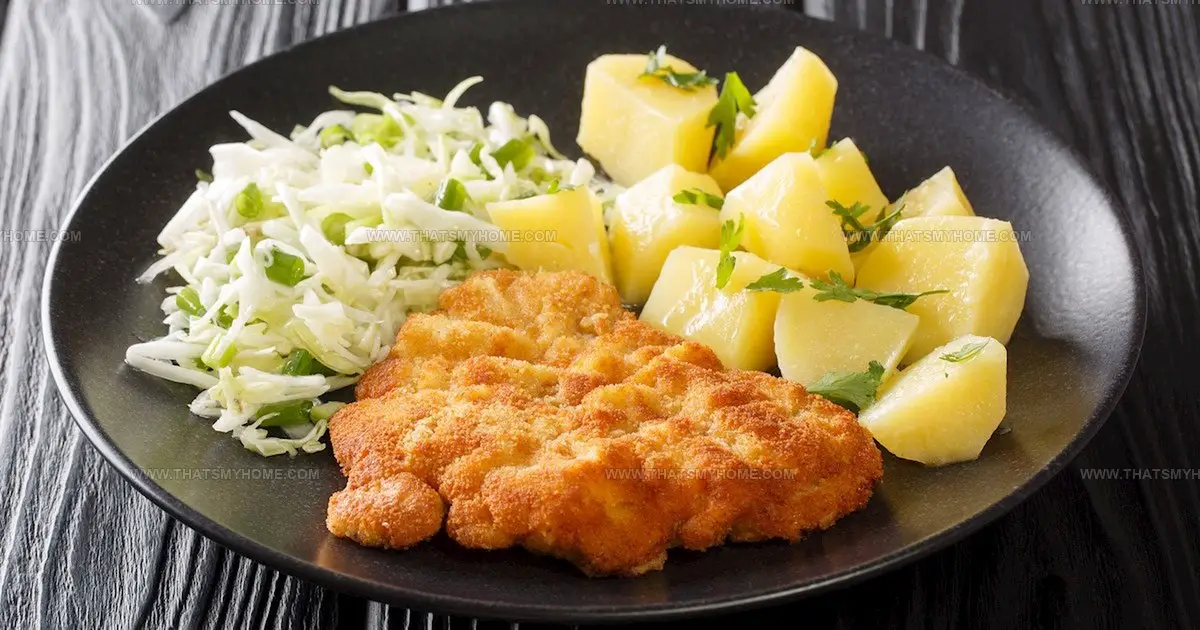

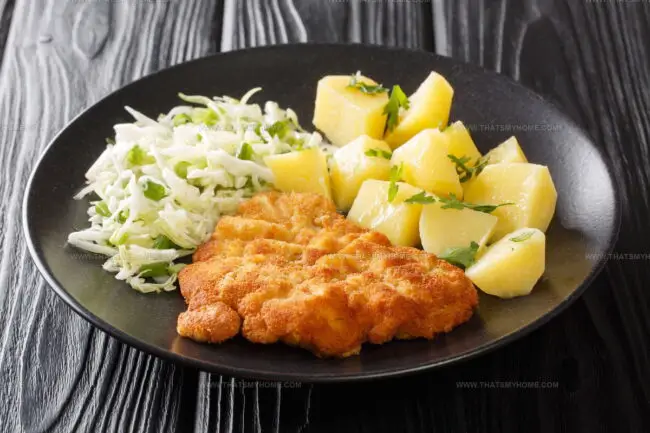
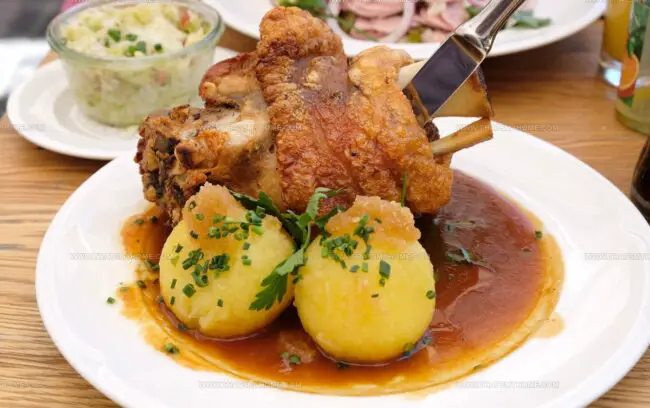
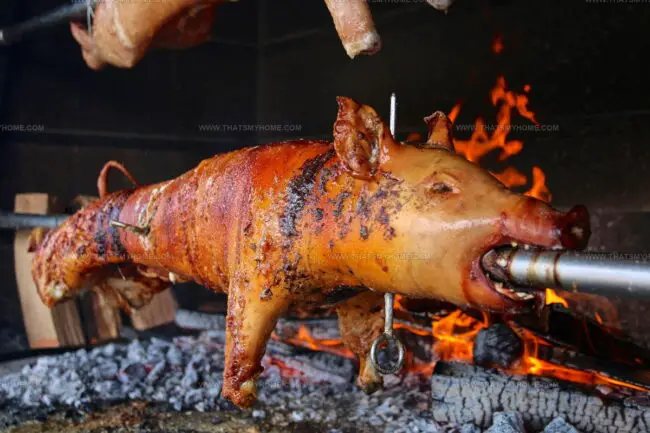
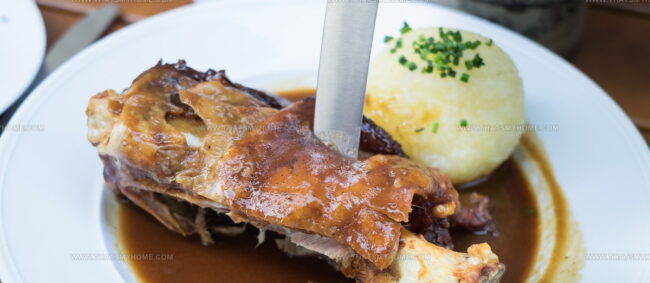
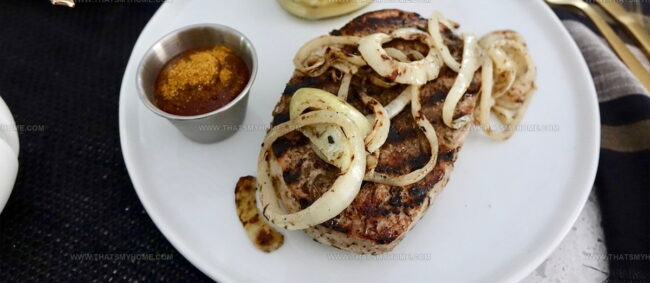
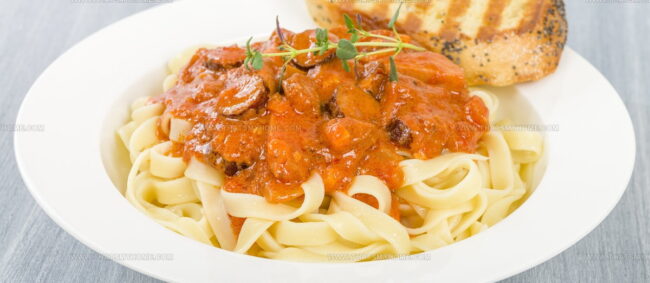
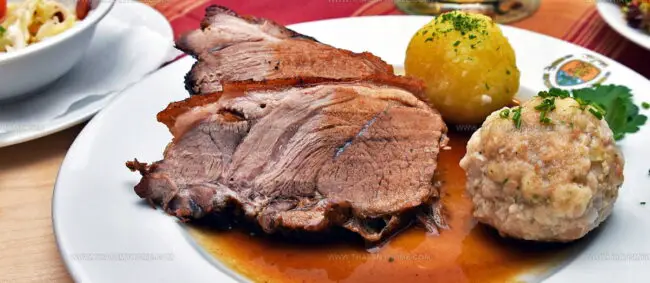
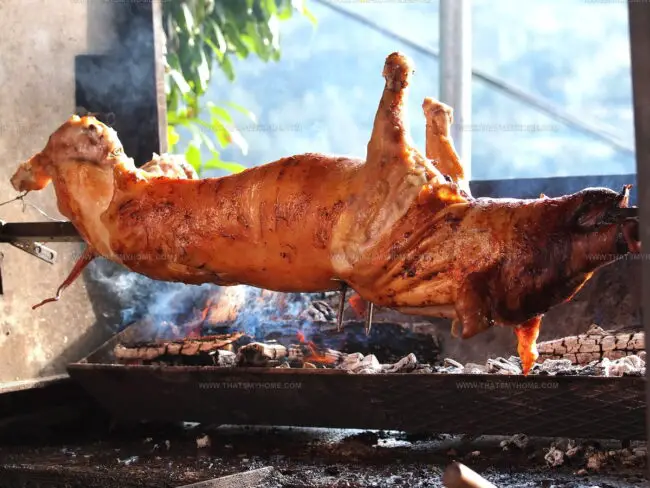
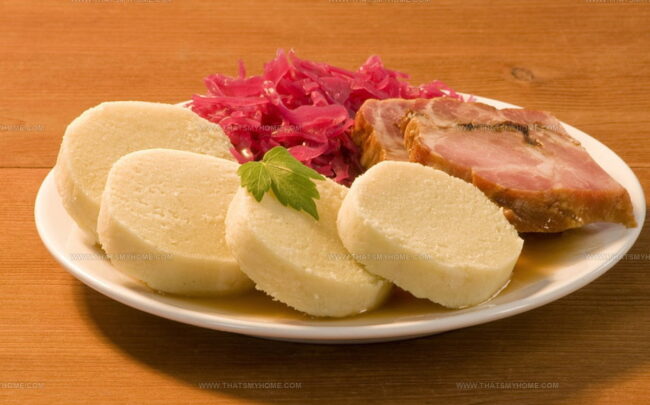
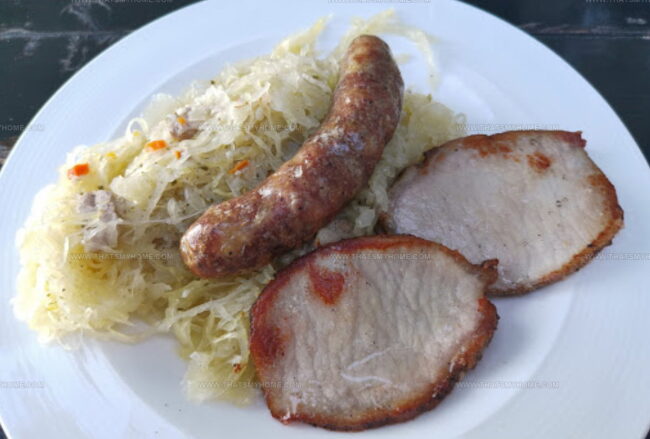
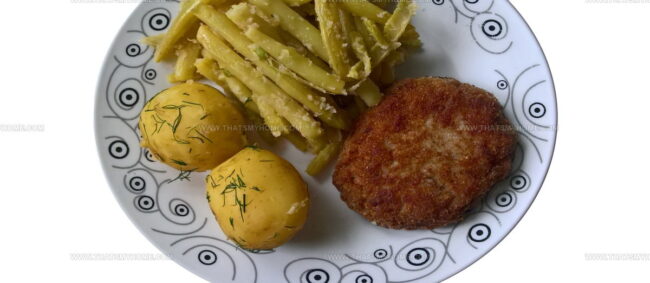
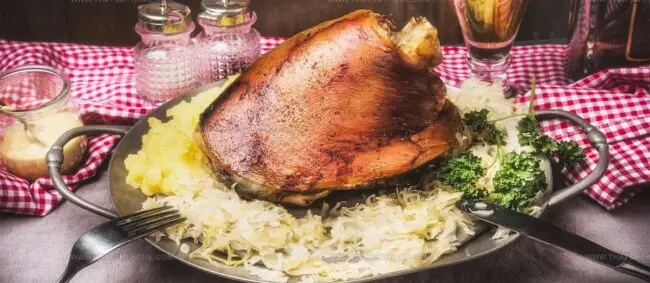
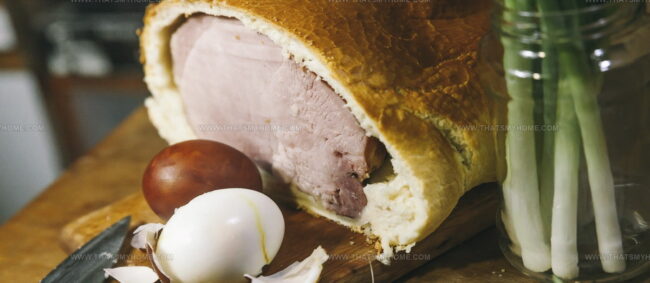
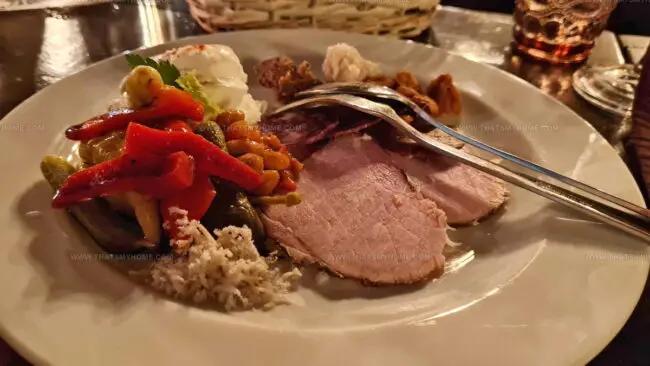
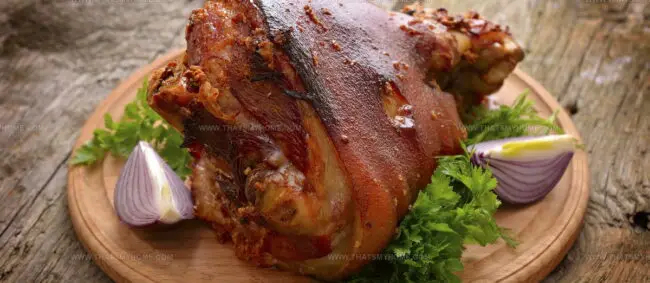
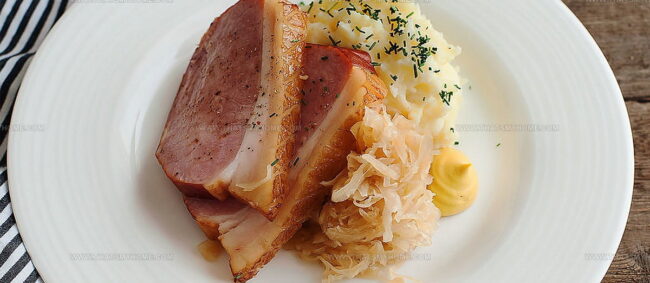

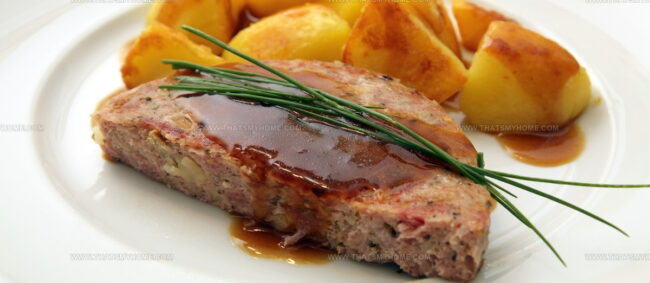
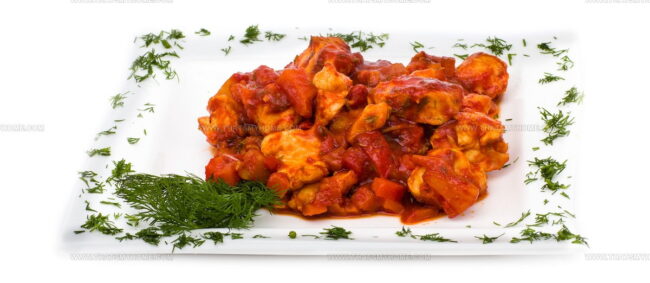
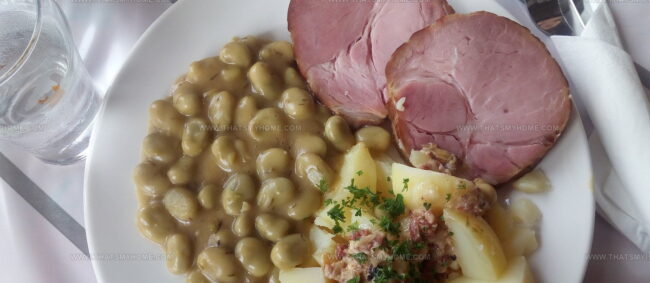

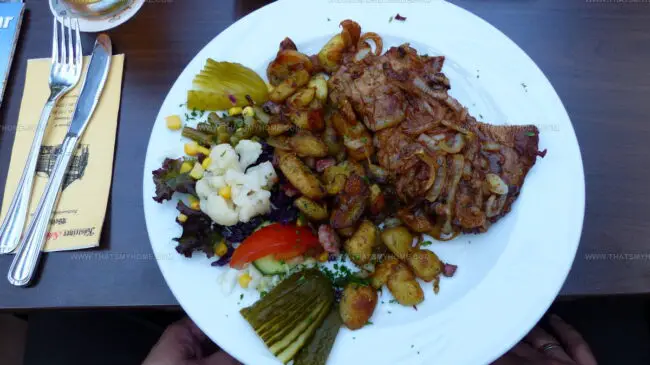
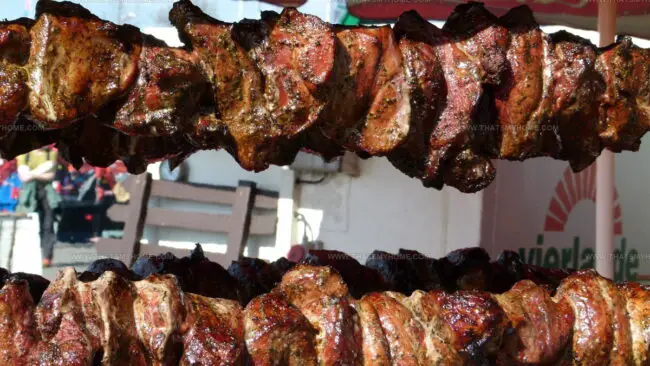
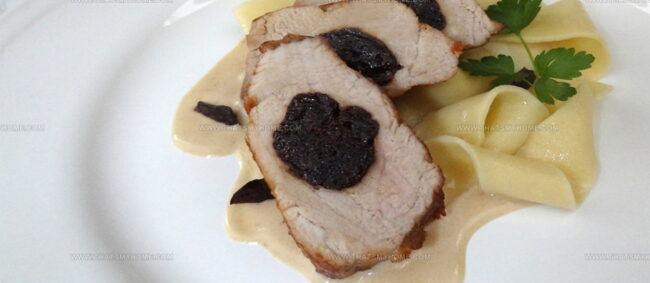
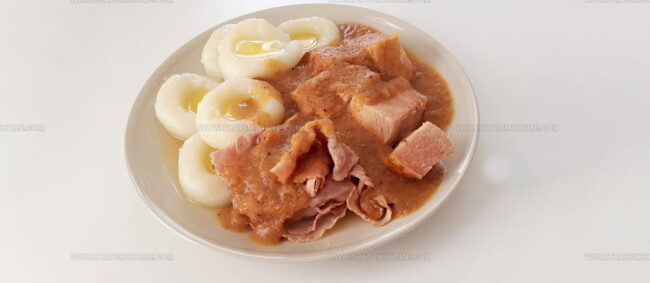
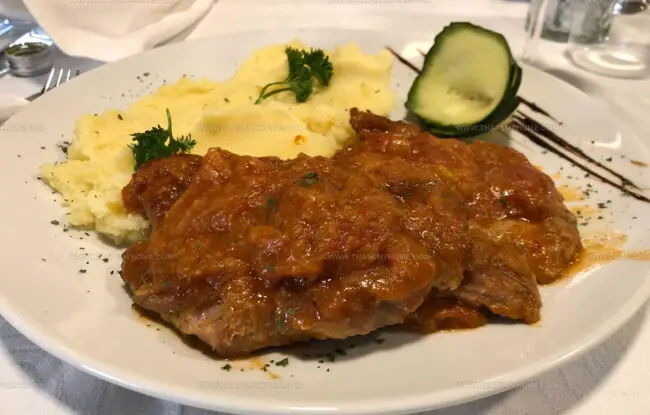
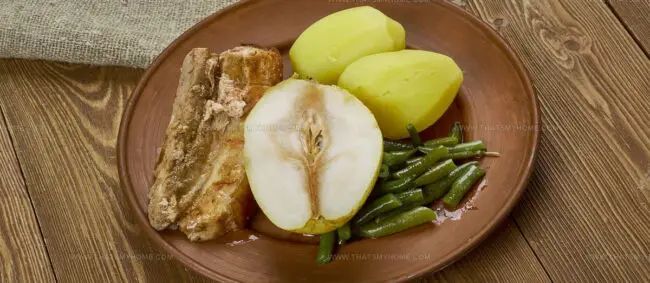
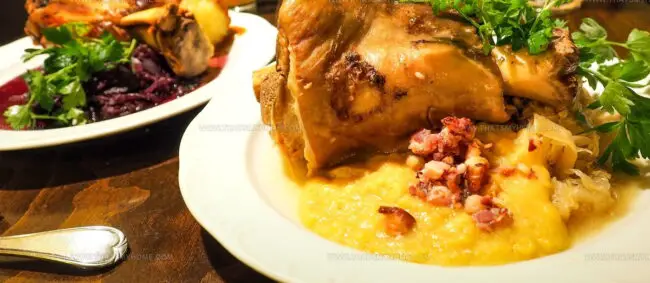
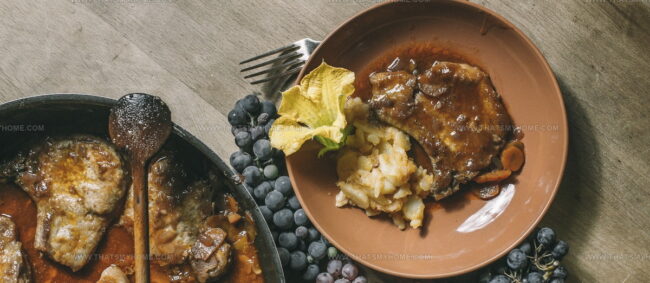
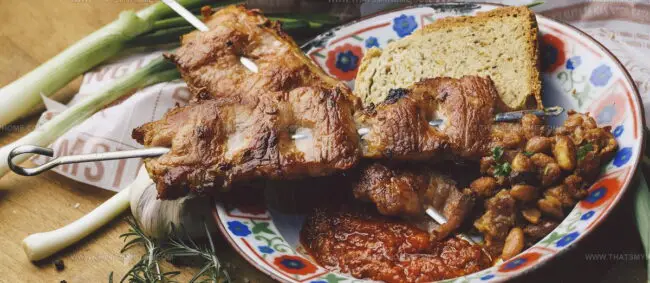
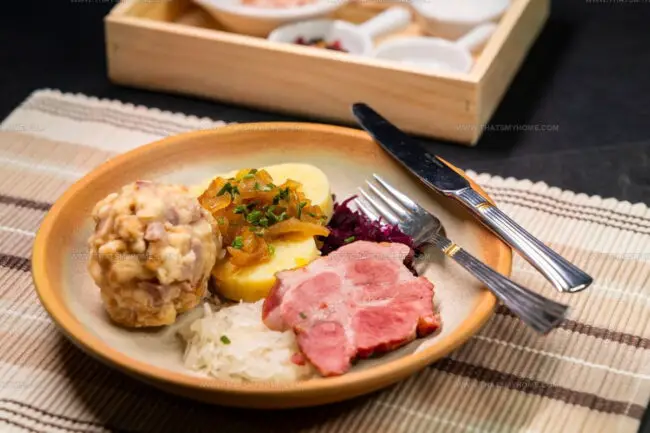
Mary Ellen
Founder, Pastry Chef & Recipe Developer
Expertise
Education
Savannah Technical College
Mary Ellen is the heart and soul of thatsmyhome.com. As the founder, pastry chef, and recipe developer, she refined her skills at Savannah Technical College with an Associate of Applied Science in Culinary Baking & Pastry Arts.
Mary blends classic techniques with modern twists to make artisanal breads, beautifully crafted pastries, and desserts full of unique flavor. Her passion is evident in every recipe, and she enjoys sharing her expertise through hands-on pastry workshops and insightful articles in local culinary magazines.